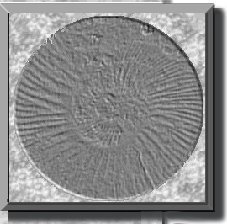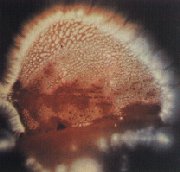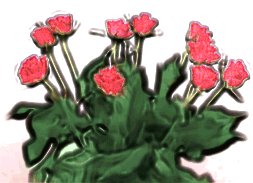

 |
Did You Know? |
| Kirlian Photography | |
| Plant Conciousness | |
 |
Did You Know?
The Earwig is said to crawl into a sleepers ear and die, however did you know that this insect gains its name, not for invading the ear, but for its resemblance to a type of forceps once used to pierce ears. This insect was also used at one time to cure earache. A liquid of crushed earwigs was once used as a cure for this painful problem. The European bush-cricket was once used for medicinal purposes...It would bite people warts, secreting a black digestive enzyme that would supposedly make the warts vanish! The adult male Duck-billed Platypus has poisonous spurs on its hind legs, capable of giving a nasty sting. There are also many different species of venomous shrew. The legendary Pheonix; a bird which supposedly caught fire and was reincarnated
from its ashes, may have been based on the fact that many birds are pyromaniacs.
Rooks are just one of the many species of bird that collect things such
as smouldering cigarette ends, and burning twigs.
|
 |
Kirlian Photography
In 1939, repairing an electrotherapy machine in a research laboratory in Krasnodar in the Ukraine, this Russian engineer got his hand too close to a live electrode. The shock he received was accompanied by a spark of light like that in a tube where neon is electrically charged. Another account says the event happened in Krasnodar hospital not to him but to a patient receiving electrotherapy. Either way, he wanted to know what happened if he put light-sensitive material in the path of the spark. With his wife Valentina he set up two metal plates as electrodes and placed photographic film on one. Putting his hand between the plates he turned on the current. The developed film showed a glowing aura round his fingertips. Extending the experiment he found similar effects in a wide range of organic tissue. The stem of a newly cut flower showed sparks streaming from the stem. A dead leaf showed neither spark nor flare. More oddly, the photograph of a newly-torn leaf still showed the part which had been torn away. Speculation about such phenomena reached the West only when in 1973
two American writers published Psychic Discoveries behind the Iron Curtain.
It was assumed by many that what Kirlian had captured on film proved the
existence of the aura as in mediaeval images of saints, or of the 'astral
body', the spiritual double of our physical selves said by some to survive
death. Such excitement was opposed by scientific assertion that the Kirlian
effect is explicable by ordinary physics, and already known. Nikola Tesla
had produced similar effects in the 1890s; in the 1930s George de la Warr
discovered weak 'electromagnetic force fields' round the body; and since
the early twentieth century electrical engineers had used a similar technique
('Lichtenburg figures') to pinpoint sudden changes in voltage.
|
 |
Yet none of this really denied the notion that astral body and aura
alike may be essentially electrical or electromagnetic in origin. And yet
again 'science' ignored the emotional productions of mind as irrelevant.
Recent Kirlian research shows that the 'aura effect' varies according to mood. Kirlian photos show the aura of young men flaring up if a pretty girl enters the room, and likewise just after they drink a shot of hard spirits. Such 'flares' also emerge at just those bodily points identified as meridians in Chinese acupuncture. Kirlian technique is now used by some therapists to diagnose illness before physical symptoms manifest. Success rates are not known. Dr Victor Inyushin of the University of Alma-Ata, USSR, has concluded
that the 'aura' effect of Kirlian photography proves the existence of what
he calls 'biological plasma', his description of which parallels the 'body
of energy' or 'astral body' described for so long by clairvoyants. At the
Neuropsychiatric Institute of UCLA, California, Kirlian energy flares have
been photographed emitting from the fingertips of healers - which may help
explain why so many healers are exhausted after such sessions.
|
 |
Plant Consciousness
In 1966 ex-CIA employee Cleve Backster hooked household plants up to a polygraph (lie-detector) and demonstrated their seeming awareness not only of threatening stimuli, but of the mere intencion of threat. When he decided to burn the leaf of a Draecaena plant, the plant reacted instantly, the polygraph needle leaping up. Apparently the plant had `read his mind'. When he entered the room with matches, the plant again reacted. From this and other experiments he concluded that plants display a form of telepathy that he was careful to term, neutrally, `primary ponception'. Gardeners and farmers long have known that certain plants germinate only if planted at specific times of the year or under specific phases of the moon. The waxing moon is the best time to plant annuals bearing above-ground crops; the waning moon is the time to plant biennials, perennials, bulb and root-crop plants, and pruning and harvesting should be done in the waning moon. Such processes may suggest no more than vegetative response to cosmic rhythms and energies. Yet the response can be extraordinarily powerful. The growing roots of trees can split rocks and dislodge houses. In 1984 a report appeared in the New Scientist of a tumescence under the tarmac of an English street. Finally the tarmac burst open to reveal an edible pink-gilled mushroom of a sort which could be crushed between finger and thumb. The mechanism governing such processes remains unknown.' Belief in `plant consciousness' is ancient. Neoplatonist philosopher Plotinus considered that plants `aspire to contemplation'. In the nineteenth century Gustav Fechner suggested that plants have `souls', a sort of psychic identity (a theory to which Findhorn gardeners would subscribe). A century ago Indian physicist and botanist Jagadis Chandra Bose showed that plants react to `blows' or `irritation' much as animals do. Though he called the effect `electrical', his work was so unorthodox that, once his talk of a `pervading unity' became known, he was ignored as a mystic. Botanist Joseph Sinel met a similar fate when (in his book The Sixth Sense, 1927) he claimed publicly that plants are clairvoyant. Testing to find how a climbing plant finds suitable holds, he observed how a wall-plant grows towards the nearest nail in the wall. `If there are two nails near each other, it will select the more suitable one, an old rusty and crooked one having the preference.' He also noted how the sticky hairs of sun-dew, an insectivorous bog-plant, usually held upright to seize insects, turn upside-down if insects are unavailable. He wrote, `If a dead fiy is now stuck upon the point of a needle and fixed an inch or two away from the plant, a decided movement of the leaves will commence.' The sundew not only has a sense of direction but knows what is or is not edible: Sinel's tests showed that its leaves ignored inedible material. Such anomalies are usually seen only in terms of`electric
The bestselling The Secret Life of Plants (1973) was ridiculed for some of its more bizarre claims. Do plants really dislike rock music, but grow well to Vivaldi or Bach? One may ask: why not? Musical rhythms whether rock or baroque derive from natural rhythms to which plants, belonging to the planetary bioenergetic field, respond as do other forms of life. Why `consciousness' should be narrowly limited in scope to human beings (and denied even to human beings by some behavioural reductionists) is a matter for continuing amazement. |